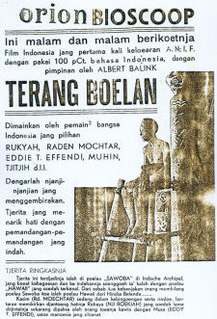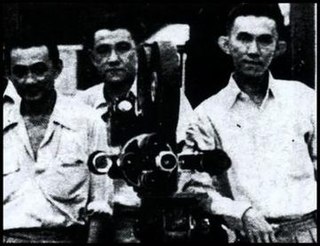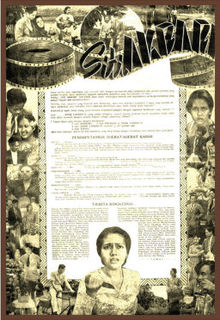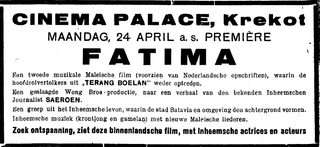Lief Java (literally "Sweet Java") was an orchestra in the Dutch East Indies (now Indonesia). It was one of the first keroncong groups in the colony. [1]
Lief Java (literally "Sweet Java") was an orchestra in the Dutch East Indies (now Indonesia). It was one of the first keroncong groups in the colony. [1]
Various musicians are recorded as having been part of the Lief Java orchestra. This includes Ismail Marzuki, a singer-cum-songwriter known for his nationalist works; [2] the blind singer Annie Landouw; [3] and the theatrically-trained husband and wife team Kartolo and Roekiah. [4] Other members included Hugo Dumas, Atjep, and Miss Netty. [5]
Lief Java was established in 1918 by Soewardi as the Rukun Anggawe Santoso Orchestra before changing its name to Lief Java in 1923. The orchestra used a variety of instruments, including cellos, flutes, guitars, and violins. Most of the artists were amateurs, with little previous experience. The orchestra practiced in Kampung Kepuh, Kemayoran, Batavia (now Jakarta), in the home of musician S. Abdullah, and played a variety of songs, both originals and arrangements or adaptations. [5] The company had two musical divisions, keroncong and jazz. [6]
Sometime after 1925, after Dutch entrepreneurs established NIROM, Lief Java began playing music over the radio as part of the station's Eastern Programme. [7] This helped the orchestra to grow in popularity and reach new audiences outside of Batavia. Ultimately, however, the orchestra left NIROM owing to concerns over the use of their intellectual property; NIROM appropriated a song they had composed for use in opening all of their broadcasts. Thus, sometime after 1937 the orchestra quit NIROM [8] and joined the rival station VORO (Vereeniging voor Oostersche Radio Omroep), playing live every Saturday. [9] By the mid 1930s Hugo Dumas was the orchestra's leader. [10]
In 1938 Lief Java completed its first film score, working for Tan's Film on its production Fatima . [11] As Roekiah was the main star of Tan's, the orchestra was retained to score the company's later releases. This included Gagak Item (1939) [12] and Siti Akbari (1940). [13] Some of the orchestra's singers, such as Kartolo and Landouw, joined the company as actors. [4] [14] The orchestra also toured; one trip, to Borneo in 1939, is known to have been a commercial success. [15]
During the Japanese occupation of the Dutch East Indies, the troupe changed their name from the Dutch Lief Java to the Japanese Kireina Djawa. During this period the orchestra performed live on several occasions, and their songs became increasingly pro-East Asian. [16] The orchestra was still in existence in 1949. [1]
An article in Pedoman Radio described the orchestra as "the 'mother' of the vocal and musical arts of Indonesia" ("'Ibu' seni-suara dan seni-musik Indonesia"). [1]

Ismail Marzuki was an Indonesian composer, songwriter and musician who wrote around 202 to 240 songs between 1931 and 1958, including numerous popular patriotic songs. Among his best-known works are "Halo, Halo Bandung", "Gugur Bunga", and "Rayuan Pulau Kelapa". In 1968, he was honoured with the creation of the well-known Taman Ismail Marzuki which is a cultural centre in Menteng in central Jakarta. In 2004 he was declared one of the National Heroes of Indonesia.

Djadoeg Djajakusuma was an Indonesian film director and promoter of traditional art forms. Born to a nobleman and his wife in Temanggung, Central Java, Djajakusuma became interested in the arts at a young age, choosing to pursue a career in theatre. During the Japanese occupation from 1943 to 1945 he was a translator and actor, and in the four-year national revolution which followed he worked for the military's educational division, several news agencies, and in drama.

Terang Boelan is a 1937 film from the Dutch East Indies. Written by Saeroen, directed by Albert Balink, and starring Rd Mochtar, Roekiah and Eddie T. Effendi, Terang Boelan follows two lovers who elope after one is almost forced to marry an opium smuggler. The film was shot in the Indies and Singapore, and was partially inspired by the 1936 Hollywood film The Jungle Princess. It was aimed at native audiences and included keroncong music, which was popular at the time, and several actors from Balink's previous work Pareh (1936).

Roekiah, often credited as Miss Roekiah, was an Indonesian kroncong singer and film actress. The daughter of two stage performers, she began her career at the age of seven; by 1932 she had become well known in Batavia, Dutch East Indies, as a singer and stage actress. Around this time she met Kartolo, whom she married in 1934. The two acted in the 1937 hit film Terang Boelan, in which Roekiah and Rd Mochtar played young lovers.

The Wong brothers were three ethnic Chinese film directors and cameramen active in the cinema of the Dutch East Indies. The sons of an Adventist preacher, the brothers – Nelson (1895–1945), Joshua (1906–1981), and Othniel (1908–1986) – received much of their education in the United States before going to Shanghai and establishing The Great Wall Productions.

Roekihati is a 1940 film from the Dutch East Indies. Directed by the brothers Joshua and Othniel Wong and produced by Tan's Film, it follows a young village woman who goes to the city and encounters various difficulties. Targeted at lower-class audiences, it was shot in black-and-white and starred Roekiah and Raden Djoemala.

Raden Mas Kartolo was an Indonesian actor and songwriter. Born in Yogyakarta to a noble family, he entered the theatre and married the actress Roekiah around 1933. The two, living in Batavia acted in numerous movies together, starting with the 1938 hit Terang Boelan. However, Roekiah was always cast with other actors as her romantic interest. After Roekiah died in 1945, Kartolo brought the family to Yogyakarta and worked with Radio Republik Indonesia until his death. One of his sons, Rachmat Kartolo, went on to be an actor in the 1960s and 1970s.

Siti Akbari is a 1940 film from the Dutch East Indies directed by Joshua and Othniel Wong and produced by Tan Khoen Yauw. Starring Roekiah and Rd Mochtar, it follows a couple while the husband commits adultery.

Fatima is a 1938 film from the Dutch East Indies directed by Othniel and Joshua Wong. Written by Saeroen, it starred Roekiah, Rd Mochtar, and ET Effendi and followed two lovers who are disturbed by a rich youth. The film followed the same formula as the earlier hit Terang Boelan, and saw commercial success domestically. It is one of three films which Misbach Yusa Biran credits with reviving the domestic film industry, which had been faltering.

Gagak Item is a 1939 bandit film from the Dutch East Indies directed by Joshua and Othniel Wong for Tan's Film. Starring Rd Mochtar, Roekiah, and Eddy T. Effendi, it follows a masked man known only as "Gagak Item". The black-and-white film, which featured the cast and crew from the 1937 hit Terang Boelan, was a commercial success and received positive reviews upon release. It is likely lost.

Matjan Berbisik is a 1940 film from the Dutch East Indies which was directed by Tan Tjoei Hock and produced by The Teng Chun. Starring Hadidjah and Mohamad Mochtar, the film follows two men who are raised as brothers and compete for the love of the same woman. A copy of the black-and-white film, which featured keroncong music, is stored at Sinematek Indonesia.

Sorga Ka Toedjoe is a 1940 film from the Dutch East Indies directed by Joshua and Othniel Wong for Tan's Film. It follows an older couple who are reunited by another, younger couple after years of separation. The black-and-white film, the first production by Tan's Film after the departure of Rd Mochtar, featured kroncong music and was targeted at lower-class native audiences. It was a commercial and critical success. Roekiah and Djoemala took leading roles in three more films before Tan's closed in 1942. Sorga Ka Toedjoe is now thought lost.
Noesa Penida is a 1941 film from the Dutch East Indies which was directed by Andjar Asmara and produced by The Teng Chun of Java Industrial FIlm. It tells of a love triangle between two brothers, born to a commoner, and a noble woman.

Annie Landouw was an Indonesian keroncong singer and film actress.
Djaoeh Dimata is a 1948 film from what is now Indonesia written and directed by Andjar Asmara for the South Pacific Film Corporation (SPFC). Starring Ratna Asmara and Ali Joego, it follows a woman who moves to Jakarta to find work after her husband is blinded in an accident. SPFC's first production, Djaoeh Dimata took two to three months to film and cost almost 130,000 gulden.

Ismail Djoemala was an Indonesian actor active in the 1940s. He was often cast alongside Roekiah as her romantic interest.

Poesaka Terpendam is a 1941 film from the Dutch East Indies produced by Tan's Film and starring Roekiah, Djoemala, and Kartolo.
Koeda Sembrani is a film from the Dutch East Indies which began filming in 1942 and was completed sometime before 1943. Released by Tan's Film and directed by Joshua and Othniel Wong, it was the last film featuring the romantic partnership of Roekiah and Djoemala.

Basoeki Resobowo was an Indonesian painter. Born to a transmigrant father in Sumatra, from a young age he showed interest in the visual arts but was taught to be a teacher. After a short time at a Taman Siswa school in Batavia, he studied design and worked as a surveyor while producing sketches and book covers. He only acted in a single film, Kedok Ketawa, but remained close to the acting community, first as a set designer during the Japanese occupation of the Dutch East Indies then for Perfini in the early 1950s.